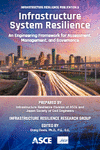Chapter 1
Introduction
Publication: Infrastructure System Resilience: An Engineering Framework for Assessment, Management, and Governance
Abstract
Disasters stemming from large-scale earthquakes, floods, and other natural hazards stress a communities’ economy and social wellbeing. Communities are reliant on infrastructure systems, which are essential for supporting the social and economic institutions within them, changing the equity imbalance, and increasing their resilience. The primary objective of ‘infrastructure resilience’ is to limit damage and losses, and restore infrastructure services following an event, thereby supporting the institutions within a community (i.e., community resilience). The purpose for creating an infrastructure system resilience framework is to identify methodologies, processes, and procedures through which the resilience of all infrastructure systems can be consistently assessed, managed, and governed. The chapter also presents an overview of the key concepts discussed in this book. The book provides an overview of the outcomes of the infrastructure resilience framework. It then delves into assessment, management, and governance, and then connects the processes to community resilience.
Get full access to this article
View all available purchase options and get full access to this chapter.
References
Balaei, B., S. Wilkinson, R. Potangaroa, N. Hassani, et al. 2018. “Developing a framework for measuring water supply resilience.” Nat. Hazard. Rev. 19 (4): 04018013.
Bruneau, M., S. E. Chang, R. T. Eguchi, G. C. Lee, et al. 2003. “A framework to quantitatively assess and enhance the seismic resilience of communities.” Earthquake Spectra 19 (4): 733–752.
Cimellaro, G. P., A. M. Reinhorn, and M. Bruneau. 2010. “Seismic resilience of a hospital system.” Struct. Infrastruct. Eng. 6 (1–2): 127–144.
Cutter, S. L., L. Barnes, M. Berry, C. Burton, et al. 2008. “A place-based model for understanding community resilience to natural disasters.” Global Environ. Change 18 (4): 598–606.
Davis, C. A. 2019. “Infrastructure system resilience: Functionality and operability.” In Proc., 2nd Int. Conf. on Natural Hazards and Infrastructure. Chania, Greece: National Technical Univ. of Athens [ISSN: 2623-4513].
Davis, C. A. 2021. “Understanding functionality and operability for infrastructure system resilience.” Nat. Hazard. Rev. 22 (1): 06020005-1-6.
Davis, C., B. Ayyub, S. McNeil, K. Kobayashi, et al. 2022a. “Overview of a framework to engineer infrastructure resilience through assessment, management and governance.” In Lifelines 2022, 901–913. Reston, VA: ASCE.
Davis, C., B. Ayyub, S. McNeil, K. Kobayashi, et al. 2022b. “Infrastructure resilience: A framework for assessment, governance and management.” In Proc., 4th Global Summit of Research Institutes for Disaster Risk Reduction, Increasing the Effectiveness and Relevance of Our Institutes, 127–155. Singapore: Springer. Accessed March 19, 2023. https://www.springerprofessional.de/en/proceedings-of-the-4th-global-summit-of-research-institutes-for-/23775482.
Davis, C. A., A. Mostafavi, and H. Wang. 2018. “Establishing characteristics to operationalize resilience for lifeline systems.” Nat. Hazard. Rev. 19 (4): 04018014-1-21.
Infrastructure Resilience Division. 2021. Hazard-resilient infrastructure analysis and design, edited by B. Ayyub. ASCE Manuals and Reports on Engineering Practice No. 144. Reston, VA: ASCE.
Koliou, M., J. W. van de Lindt, T. P. McAllister, B. R. Ellingwood, et al. 2018. “State of the research in community resilience: Progress and challenges.” Sustainable Resilient Infrastruct. 5 (3): 131–151.
Loggins, R., R. G. Little, J. Mitchell, T. Sharkey, et al. 2019. “CRISIS: Modeling the restoration of interdependent civil and social infrastructure systems following an extreme event.” Nat. Hazard. Rev. 20 (3): 04019004-1-21.
Mieler, M., B. Stojadinovic, R. Budnitz, M. Comerio, et al. 2015. “A framework for linking community-resilience goals to specific performance targets for the built environment.” Earthquake Spectra 31 (3): 1267–1283.
NIST (National Institute of Standards and Technology). 2015. Community resilience planning guide for buildings and infrastructure systems. NIST Special Publication 1190. Gaithersburg, MD: NIST.
Ouyang, M., L. Duenas-Osorio, and X. Min. 2012. “A three-stage resilience analysis framework for urban infrastructure systems.” Struct. Saf. 36–37: 23–31.
Renschler, C. S., A. E. Fraizer, L. A. Arendt, G. P. Cimellaro, et al. 2010. A framework for defining and measuring resilience at the community scale: The PEOPLES resilience framework. NIST GCR 10-930. Gaithersburg, MD: US Dept. of Commerce, NIST, Office of Applied Economics Engineering Laboratory.
Rose, A. 2009. “Economic resilience to disasters.” Community and Regional Resilience Institute, CARRI Research Rep. 8, Published Articles and Papers, Paper 75. Accessed March 19, 2023. https://text2fa.ir/wp-content/uploads/Text2fa.ir-Economic-Resilience-to-Disasters-1.pdf.
The PRAISys Team. 2018. “Probabilistic resilience assessment of interdependent systems (PRAISys).” Accessed March 29, 2023. http://praisys.org/pages/research.html.
Tierney, K., and M. Bruneau. 2007. “Conceptualized and measuring resilience.” TR News 250: 14–17. Accessed April 8, 2015. http://onlinepubs.trb.org/onlinepubs/trnews/trnews250_p14-17.pdf.
United Nations. 2016. “The infrastructure–inequality–resilience nexus.” In Global sustainability development report. New York: United Nations.
UNISDR (United Nations Office for Disaster Risk Reduction). 2015. Sendai framework for disaster risk reduction 2015–2030. 1st ed. Geneva: United Nations. Accessed April 7, 2019. https://www.unisdr.org/files/43291_sendaiframeworkfordrren.pdf.
Waage, J., C. Yap, S. Bell, C. Levy, et al. 2015. “Governing the UN Sustainable Development Goals: Interactions, infrastructures, and institutions.” Lancet Global Health 3 (5): E251–E252.
Information & Authors
Information
Published In
Infrastructure System Resilience: An Engineering Framework for Assessment, Management, and Governance
Pages: 1 - 5
Editor: Craig Davis, Ph.D., P.E., G.E.
ISBN (Online): 978-0-7844-8508-8
Copyright
© 2023 American Society of Civil Engineers.
History
Published online: Sep 25, 2023
ASCE Technical Topics:
Authors
Metrics & Citations
Metrics
Citations
Download citation
If you have the appropriate software installed, you can download article citation data to the citation manager of your choice. Simply select your manager software from the list below and click Download.
